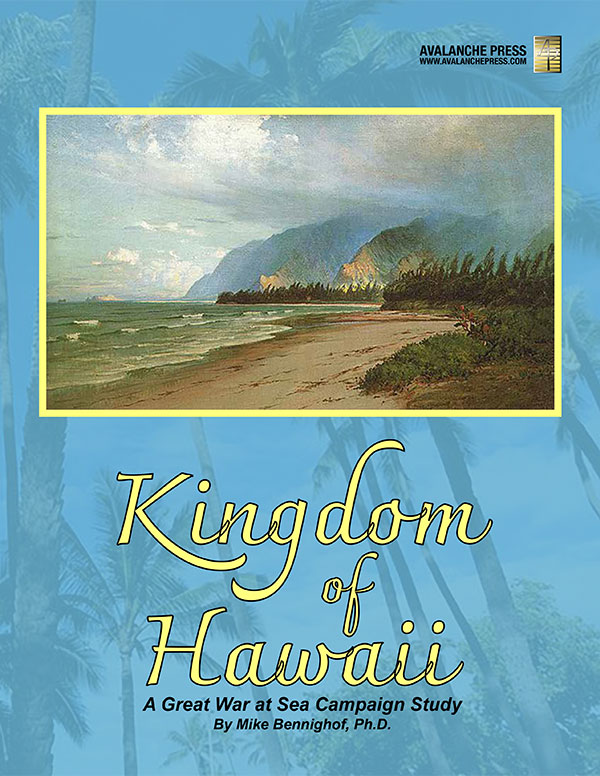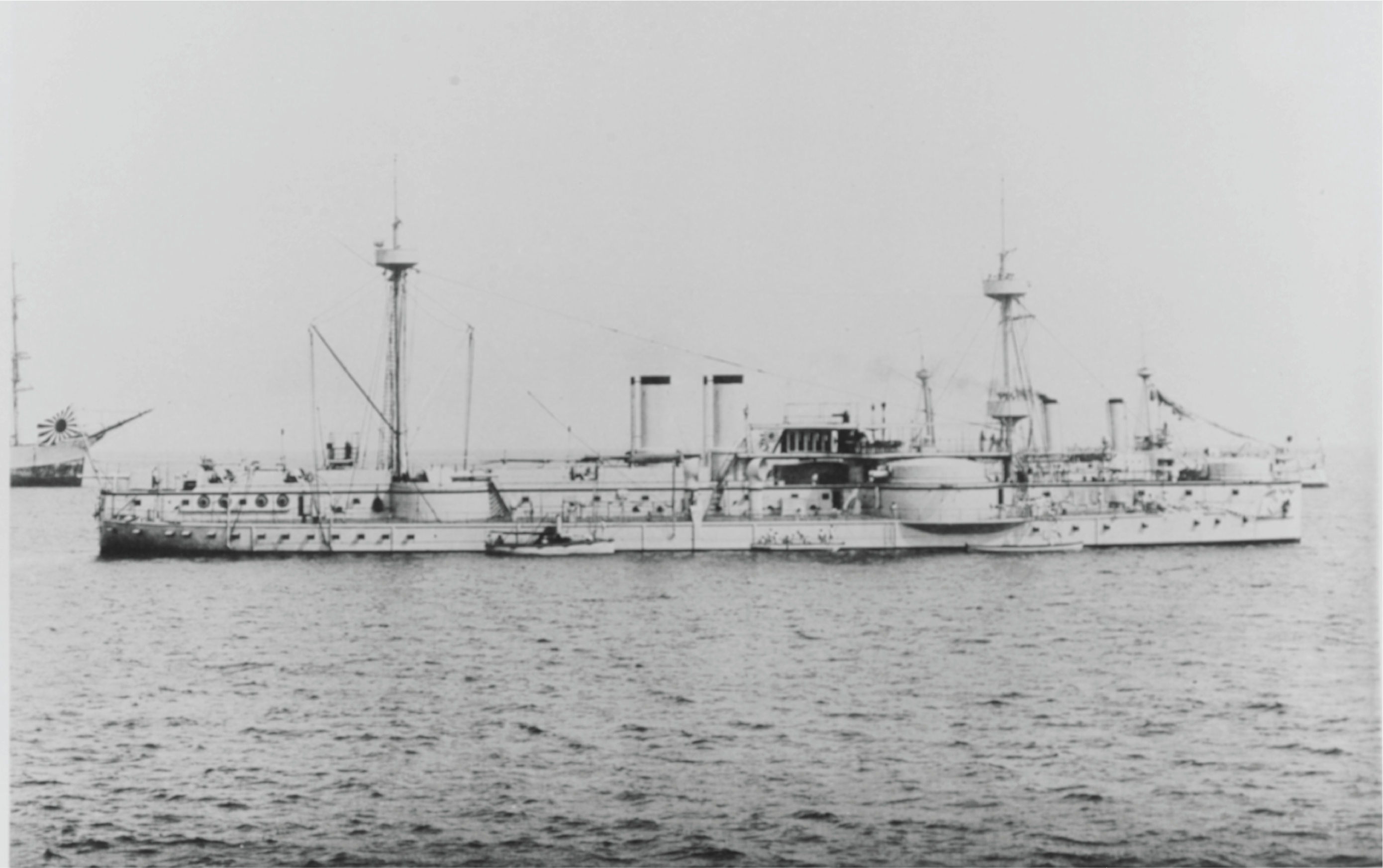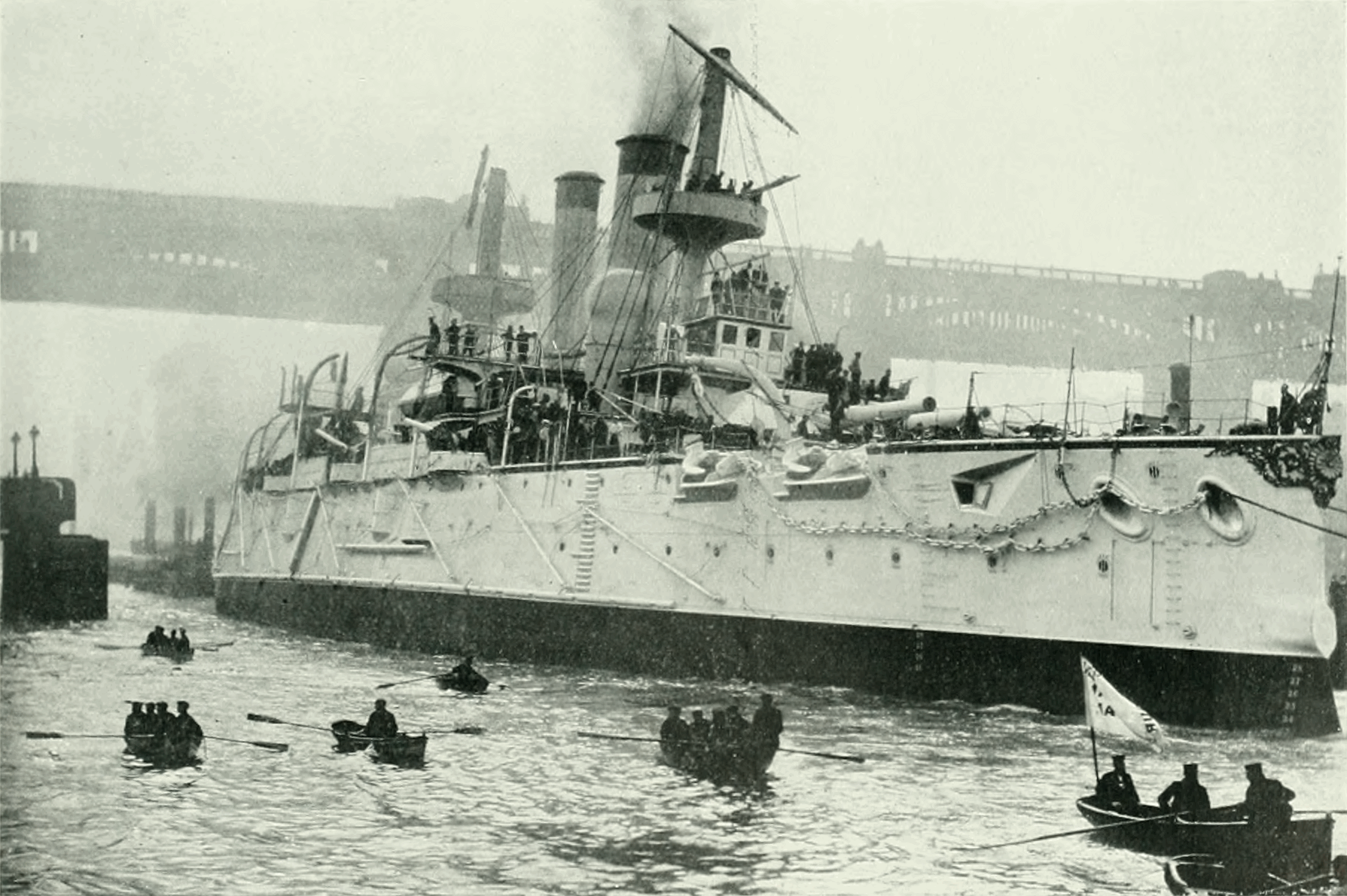| Kingdom of Hawaii
Fleets of 1897
by Mike Bennighof, Ph.D.
August 2024
 Following Japan’s victory in the 1894 Sino-Japanese War, the pace of naval construction picked up in both Japan and the United States. For different reasons, each of the emerging powers looked to move from a relatively inexpensive navy of cruisers to one built around a battle fleet. When Japan and the United States faced off over Hawaii in 1897, the first of these battleships had just started to enter service. Following Japan’s victory in the 1894 Sino-Japanese War, the pace of naval construction picked up in both Japan and the United States. For different reasons, each of the emerging powers looked to move from a relatively inexpensive navy of cruisers to one built around a battle fleet. When Japan and the United States faced off over Hawaii in 1897, the first of these battleships had just started to enter service.
Japan
The naval side of the Sino-Japanese War climaxed with the Battle of the Yalu, where Bertin’s notion of heavily-armed battleship-killing cruisers failed spectacularly. The Chinese battleships took hundreds of hits from small-caliber, rapid-firing Japanese guns, most of which simply bounced off their armor. To fight enemy battleships, the Japanese would need battleships of their own.
For the moment, Japan’s chief rival, China, had been de-fanged. The Chinese fleet had been bottled up at Wei-hai-wei, where both battleships sank. The Japanese managed to raise one of them, Chen Yüan, and take her into their own service as Chin Yen (simply a transliteration of her Chinese name, “Striking from far away”). The Japanese re-floated the ship at the end of February 1895 and towed her to the captured Chinese naval base at Port Arthur, where she was dry-docked and repaired. Commissioned on 3 March 1895, by July she was touring Japan to raucous crowds eager to celebrate the Empire’s victory. The tour concluded at Yokosuka, where she began more extensive refurbishment.

Battleship Chin Yen in Japanese service.
Chin Yen, already 14 years old at this point, represented an earlier generation of heavy warship and was not by any means a front-line unit. The Imperial Navy re-designated her as a “second-class battleship,” and in March 1898 she shifted from the Combined Fleet to the Reserve Fleet, as modern new battleships took her place.
Émile Bertin built the Japanese fleet around cruisers, because the Empire could not afford battleships. That was still the case when, soon after his departure, the two Chinese battleships visited Yokohama. And while some Japanese officers were unimpressed, Prime Minister Masayoshi Matsutaka believed that Japan needed battleships of her own, and attempted to order two of them from British shipyards. Repeated attempts not only failed in the Diet, but led to the fall of his government; his successor likewise failed.
In February 1893, Emperor Mutsuhito intervened, offering to fund the battleships through a six-month reduction in the Imperial Household, while asking civil servants to accept a 10 percent pay cut toward the same cause. Suitably shamed, the Diet not only funded the new battleships, but paid for an accelerated delivery schedule.
Fuji and Yashima, though designed by different British architects, were almost identical and are considered a single class. They drew heavily from the contemporary British Majestic class, with twin turrets mounted fore and aft for 12-inch guns; most of the 6-inch guns of their secondary battery occupied shielded mounts on the main deck rather than armored casemates. They had good speed for their era (18.5 knots) and thicker armor than British battleships, though they shared the then-new Harvey treated steel plate.
Though rumor at the time claimed that the new battleships would steam directly from England to Hawaii, they in fact did not commission until August and September 1897 (six months after the Hawaii Crisis) and arrived in Japan in February 1898.

Battleship Yashima nears completion at Newcastle, England. June 1897.
Funding those battleships came at the expense of just about anything else. The cruiser Akitsushima had been planned as the fourth unit of the Matsushima class, but was built instead as a modified version of the American cruiser Baltimore, to a design purchased from a British shipyard but built in Japan with imported parts. A pair of small cruisers, Suma and Akashi, would be the first large warships built to a Japanese plan, but only Suma was in service when the Hawaii Crisis broke out. The Japanese also purchased the decade-old cruiser Esmerelda from Chile just before the Sino-Japanese War broke out, re-naming her Idzumi; her low freeboard made her useful only in coastal waters even after the Japanese had greatly reduced her armament.
Less useful were two more ex-Chinese prizes, the slow protected cruiser Sai Yen, also built in Germany and featuring a pair of 8.2-inch guns in a single turret, and the small armored gunboat Hei Yen, built at the Foochow Arsenal in China. Originally intended as a much larger warship, when cut down for budgetary reasons the result was a painfully slow, thickly armored vessel sporting a single 10.2-inch gun. It’s doubtful she could have made the voyage to Hawaii.
Despite heavy spending, the Imperial Navy was not much stronger in 1897 than it had been in 1893. Japan began to build and purchase much more capable warships under the 1896 Ten Year Naval Expansion Program, but these would not be ready in time for the Hawaii Crisis.
United States
Aversion to a deep-water battle fleet ran strongly in both the political and military leadership of the United States in the 1880’s. Such a fleet would be enormously expensive, and entangle the nation in overseas affairs when it still had not absorbed the vast territories of the American West.
Following that philosophy, the first American battleships (the Indiana class) were termed “coast defense battleships” in their June 1890 authorization. Resembling oversized monitors more than European battleships, they came in enormously overweight even after the builders conducted trials with a fraction of their coal and ammunition loads. Since the United States could not yet manufacture quick-firing guns, they carried the biggest slow-firing guns that American factories could produce: four 13-inch guns in two twin turrets fore and aft, and a secondary battery of eight 8-inch guns in twin turrets, plus four slow-firing 6-inch guns (these latter two guns were the same models fitted on the early cruisers).

Battleship Oregon visits New York, just after the Spanish-American War.
Two of these ships, Indiana and Massachusetts, were built by William Cramp of Philadelphia; the third, Oregon, came off the slipways at Union Iron Works in San Francisco. With that, the United States had staked a claim as a Pacific power.
An improved fourth ship, Iowa, had higher freeboard but otherwise shared many of Indiana’s flaws; she would not commission until June 1897, at the height of the Hawaii Crisis. She likely could have been rushed into service had a shooting war erupted off Oahu.
The U.S. Navy also built three large cruisers during the brief period between the two Hawaii Crises. Though an American design, the armored cruiser Brooklyn showed considerable French influence in her high freeboard with a pronounced tumblehome (the outward curvature of the hull) and the “lozenge” arrangement of her turrets. She was described as an improved New York, with eight rather than six 8-inch guns (all now in twin turrets). She commissioned in December 1896, just before the Hawaii Crisis, and made a few cruises to Europe and the Caribbean before the Spanish-American War erupted.
The other two cruisers were considered an integral part of the coast-defense strategy, long-range commerce raiders that would divert the attention of a potential enemy (likely Britain, but the prospect of a French-built Panama Canal also robbed U.S. Navy planners of sleep). Columbia and Minneapolis were large, lightly-protected and lightly-armed, consuming vast amounts of coal though they offered a high speed in return. Both commissioned in 1895, as did the best-designed American protected cruiser, Olympia. She had four 8-inch guns in armored turrets, an armored conning tower and armored deck, but no armored belt along her sides. Like Oregon, she was also built at Union Iron Works as part of the American West Coast naval buildup.

Cruiser Olympia in drydock at Norfolk Navy Yard, 5 October 1903.
The naval balance of 1897 depended on several variables. Firstly, the completion of the two new Japanese battleships would greatly alter the balance of power; without them, the ex-Chinese Chin Yen would be no match for Oregon, herself no match for the Japanese battleships. How many ships would the Americans send around Cape Horn to fight for Hawaii (the Panama Canal remained a dream of Teddy Roosevelt at this point)?
We can delve into all of those questions in Kingdom of Hawaii, a Great War at Sea Campaign Study featuring Japanese-American naval battles for Hawaii in the last years of the 19th Century, based on a political and diplomatic crisis that actually happened, but did not devolve into a shooting war.
You can order Kingdom of Hawaii right here.
Pineapple Empire
Remember the Maine
Russo-Japanese War
Kingdom of Hawaii
Retail Price: $142.97
Package Price: $120
Gold Club Price: $96
You can experience the Pineapple Empire Package right here.
Sign up for our newsletter right here. Your info will never be sold or transferred; we'll just use it to update you on new games and new offers.
Mike Bennighof is president of Avalanche Press and holds a doctorate in history from Emory University. A Fulbright Scholar and NASA Journalist in Space finalist, he has published a great many books, games and articles on historical subjects; people are saying that some of them are actually good.
He lives in Birmingham, Alabama with his wife, three children, and new puppy. He misses his lizard-hunting Iron Dog, Leopold.
Daily Content includes no AI-generated content or third-party ads. We work hard to keep it that way, and that’s a lot of work. You can help us keep things that way with your gift through this link right here.
|
